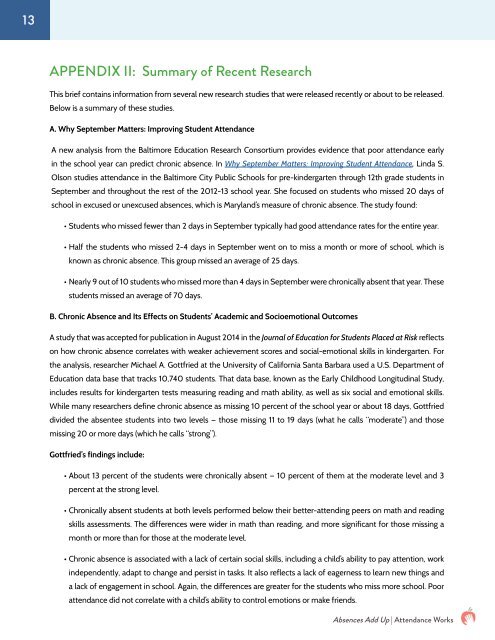Absences Add Up
1t9Q3wC
1t9Q3wC
You also want an ePaper? Increase the reach of your titles
YUMPU automatically turns print PDFs into web optimized ePapers that Google loves.
13APPENDIX II: Summary of Recent ResearchThis brief contains information from several new research studies that were released recently or about to be released.Below is a summary of these studies.A. Why September Matters: Improving Student AttendanceA new analysis from the Baltimore Education Research Consortium provides evidence that poor attendance earlyin the school year can predict chronic absence. In Why September Matters: Improving Student Attendance, Linda S.Olson studies attendance in the Baltimore City Public Schools for pre-kindergarten through 12th grade students inSeptember and throughout the rest of the 2012-13 school year. She focused on students who missed 20 days ofschool in excused or unexcused absences, which is Maryland’s measure of chronic absence. The study found:• Students who missed fewer than 2 days in September typically had good attendance rates for the entire year.• Half the students who missed 2-4 days in September went on to miss a month or more of school, which isknown as chronic absence. This group missed an average of 25 days.• Nearly 9 out of 10 students who missed more than 4 days in September were chronically absent that year. Thesestudents missed an average of 70 days.B. Chronic Absence and Its Effects on Students’ Academic and Socioemotional OutcomesA study that was accepted for publication in August 2014 in the Journal of Education for Students Placed at Risk reflectson how chronic absence correlates with weaker achievement scores and social-emotional skills in kindergarten. Forthe analysis, researcher Michael A. Gottfried at the University of California Santa Barbara used a U.S. Department ofEducation data base that tracks 10,740 students. That data base, known as the Early Childhood Longitudinal Study,includes results for kindergarten tests measuring reading and math ability, as well as six social and emotional skills.While many researchers define chronic absence as missing 10 percent of the school year or about 18 days, Gottfrieddivided the absentee students into two levels — those missing 11 to 19 days (what he calls “moderate”) and thosemissing 20 or more days (which he calls “strong”).Gottfried’s findings include:• About 13 percent of the students were chronically absent — 10 percent of them at the moderate level and 3percent at the strong level.• Chronically absent students at both levels performed below their better-attending peers on math and readingskills assessments. The differences were wider in math than reading, and more significant for those missing amonth or more than for those at the moderate level.• Chronic absence is associated with a lack of certain social skills, including a child’s ability to pay attention, workindependently, adapt to change and persist in tasks. It also reflects a lack of eagerness to learn new things anda lack of engagement in school. Again, the differences are greater for the students who miss more school. Poorattendance did not correlate with a child’s ability to control emotions or make friends.<strong>Absences</strong> <strong>Add</strong> <strong>Up</strong> | Attendance Works


